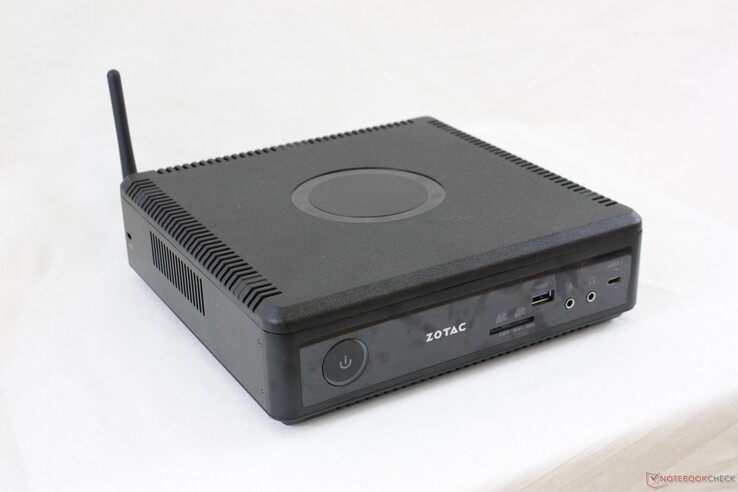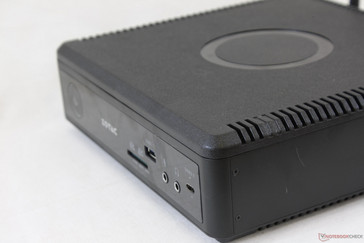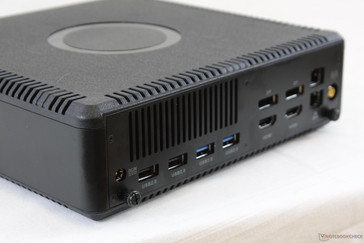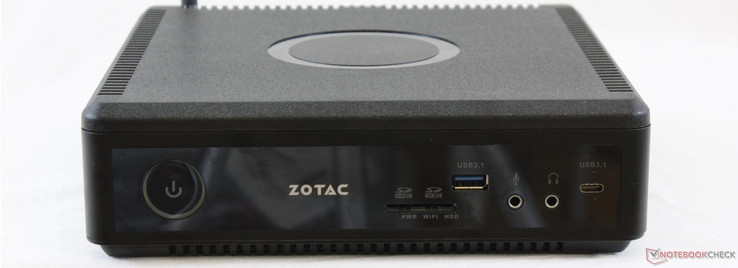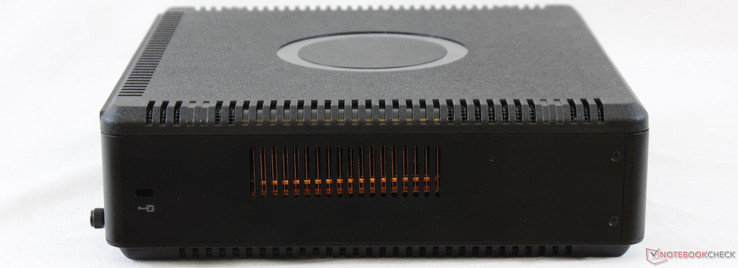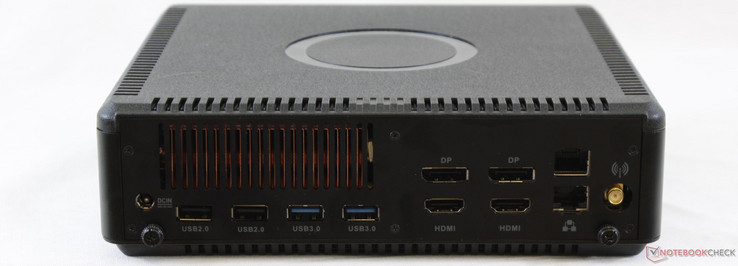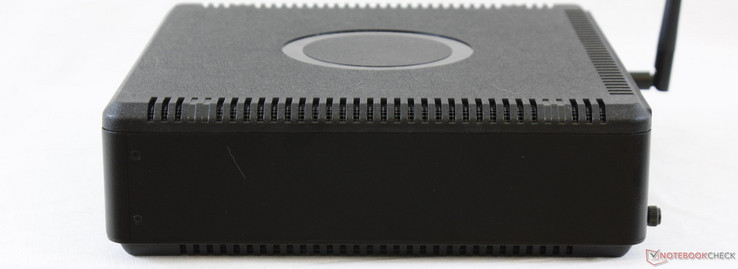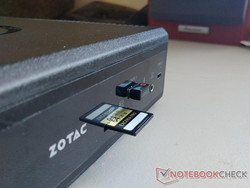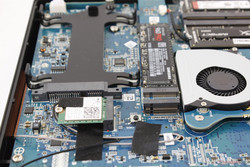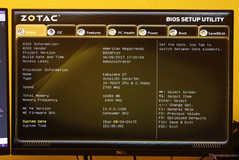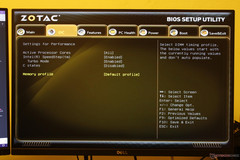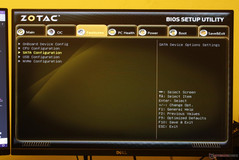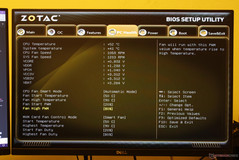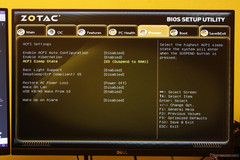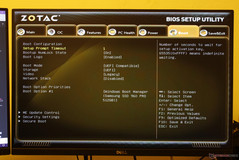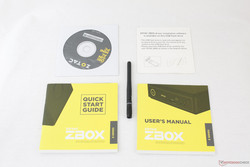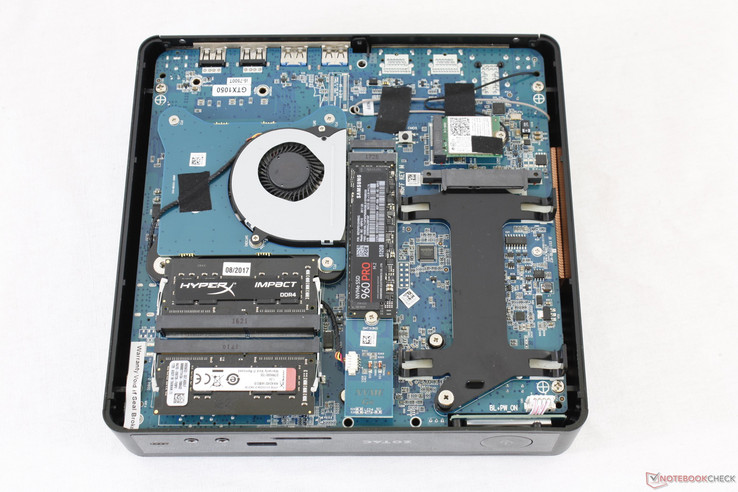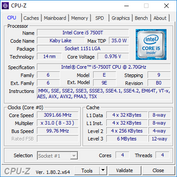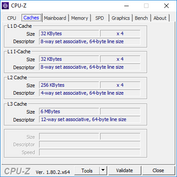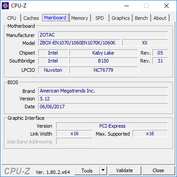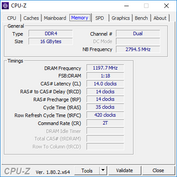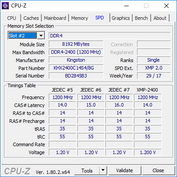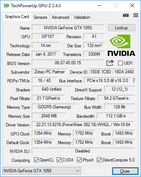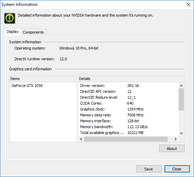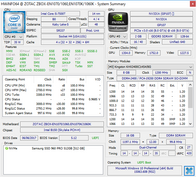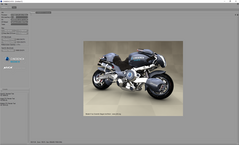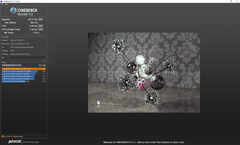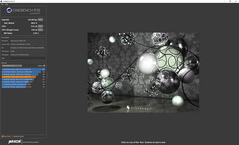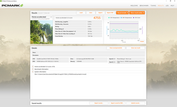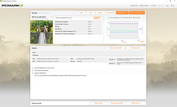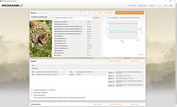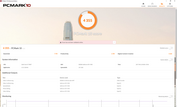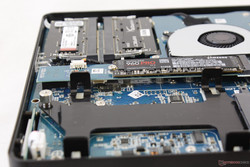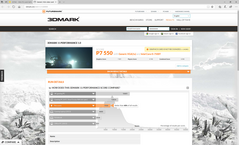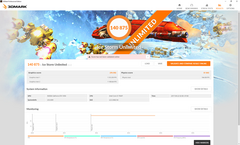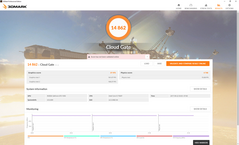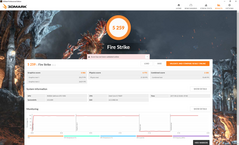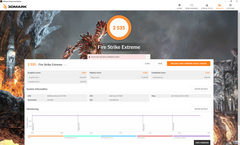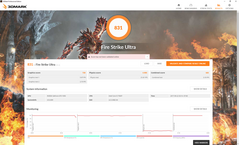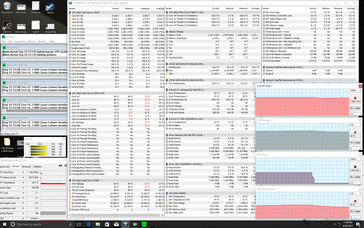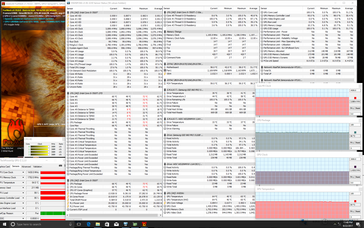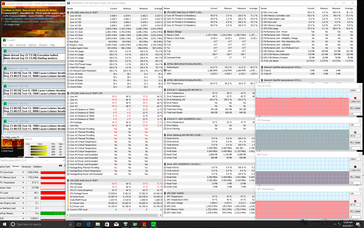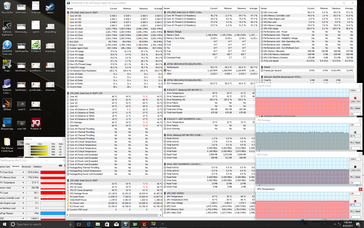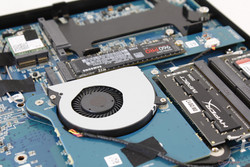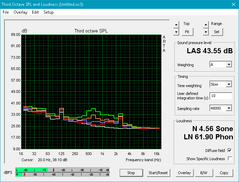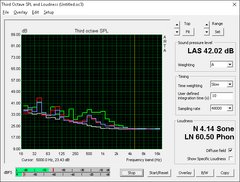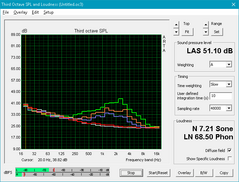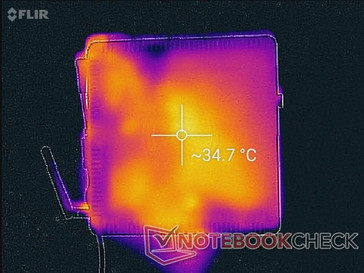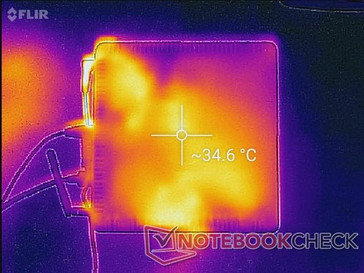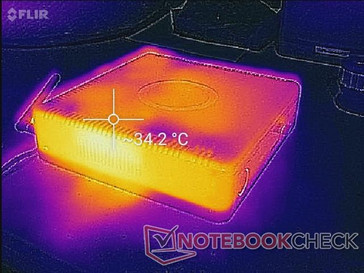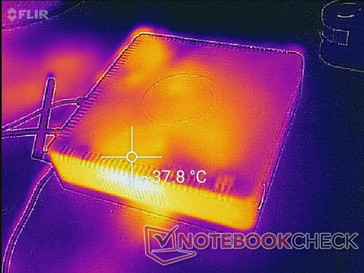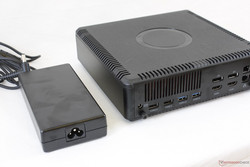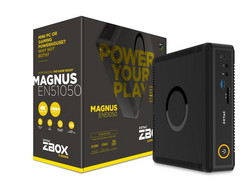Zotac ZBOX Magnus EN51050 Mini PC Review
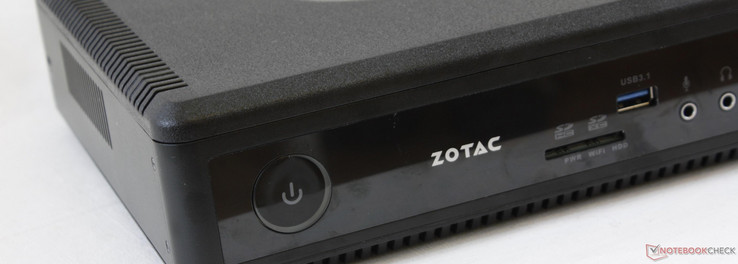
The Zotac Magnus family houses some of the most powerful gaming mini PCs for the size. The flagship EN1080K, for example, is much smaller than the console-sized MSI Trident, Asus ROG GR8, and Gigabyte Brix GB while managing to incorporate a Core i7-7700 CPU and faster GTX 1080 GPU.
Our test unit today is from the same Magnus EN family but at the mid-range level aimed at mainstream gamers. The EN51050 is the Kaby Lake update to the EN1060/1070 series and comes equipped with a Core i5-7500T and GeForce GTX 1050 to succeed both the Maxwell-based EN970 and EN760 mini PCs. Thankfully, Zotac has decided to drop the ULV U-class CPUs from the previous EN generations in favor of the faster T class to provide a better performance balance between the CPU and GPU. Additional SKUs are available in the EN family sporting GTX 1060, GTX 1070, and GTX 1080 GPUs with up to 65 W CPU options.
The barebones EN51050 kit we have on hand retails for $700 USD and will require users to outfit the unit with an operating system, HDD or SSD, and DDR4 RAM. We've installed 2x 8 GB DDR4 2400 MHz HyperX RAM modules and a 512 GB Samsung SSD 960 Pro all courtesy of Eurocom and the Eurocom Q5. When taking into account these vital components, the cost of a fully-equipped EN51050 is not all that much different from a mainstream gaming notebook with the same GTX 1050 GPU like the Gigabyte Sabre 15, HP Pavilion 15 Power, or Samsung Odyssey 15. We'll be comparing the Zotac mini PC to gaming notebooks to see what benefits and drawbacks the mini PC form factor will bring.
No, or more than one (0) Rating for the given SpecsID 283342 found
Case
The chassis is black matte plastic all around with a glossy front face. Its rough top and bottom contrast the smoother four sides in terms of texture, but the overall design feels quite dull for a gaming mini PC. Of course, some users may prefer the simplistic and understated look over RGB LED lights. The glossy front in particular is an odd choice since it will attract fingerprints very quickly from constant Power button presses and swapping of USB devices. There is unfortunately no native support for VESA mounting unlike on most mini PCs this size and vertical positioning is a bit too top-heavy if not leaning against a shelf or wall.
Case quality is otherwise excellent on our test unit. We can observe no unintended gaps or crevices between materials and applying pressure on the top center will only depress the surface just slightly. The bottom panel creaks very lightly to pressure since it was designed to be easily removed and is not held in place by an array of screws.
In terms of size, the cuboid EN51050 is compact in keeping with the tradition of a mini PC. Its width is exactly the same as the EN980 while being less than half the height and weight. Intel's Skull Canyon NUC is even smaller still, albeit significantly slower in GPU performance.
Connectivity
There is a wide selection of ports as is common on mini PCs from Zotac. The ports along the rear are now more evenly spaced unlike the overly crowded positioning of the USB ports on the Magnus EN980. Up to four 4K UHD displays can be connected simultaneously via HDMI 2.0 and DP 1.3. The dual RJ-45 ports remain, but we would've preferred just one if it had meant we could get the more versatile Thunderbolt 3 in its place.
The front of the unit integrates an IR receiver for HTPC purposes.
SD Card Reader
Transfer rates from the integrated card reader is slow at just over 40 MB/s with our Toshiba Exceria UHS-II SD card. Transferring 1 GB worth of photos from the card to desktop will take about 40 seconds compared to 20 seconds on the Sabre 15.
The card reader is not spring-loaded and a fully inserted SD card will protrude by about half its length.
| SD Card Reader | |
| average JPG Copy Test (av. of 3 runs) | |
| Gigabyte Sabre 15G | |
| Zotac ZBOX Magnus EN51050 | |
| MSI GS43VR 7RE-069US | |
| maximum AS SSD Seq Read Test (1GB) | |
| Gigabyte Sabre 15G | |
| Zotac ZBOX Magnus EN51050 | |
| MSI GS43VR 7RE-069US | |
Communication
WLAN is provided by a removable 1x1 M.2 Intel 3165 module with integrated Bluetooth 4.2. Maximum theoretical transfer rates are limited to 433 Mbps compared to twice that on the pricier 2x2 Intel 8360 or Killer 1535 series. A real-world test standing one meter away from our Linksys EA8500 router shows a steady transfer rate of about 327 Mbps.
We experienced no connectivity issues during our time with the test unit.
| Networking | |
| iperf3 transmit AX12 | |
| Eurocom Tornado F5 Killer Edition | |
| Gigabyte Sabre 15G | |
| Zotac ZBOX Magnus EN51050 | |
| iperf3 receive AX12 | |
| Eurocom Tornado F5 Killer Edition | |
| Zotac ZBOX Magnus EN51050 | |
| Gigabyte Sabre 15G | |
BIOS
The BIOS hasn't changed much since the old EN760 days. Of particular note is the independent fan speed settings for the CPU and GPU fans. By default, the minimum fan speed and maximum fan speed are set to 20 percent and 80 percent, respectively, for both processors. There is no reason to lift the 80 percent fan speed ceiling for this particular EN51050 SKU since it runs well below 90 C as our Stress Test section will show. For higher-end EN SKUs like the EN51070, however, the optional 100 percent fan speed setting will have more of a purpose. Maximum fan speed cannot be set below 60 percent for either the CPU or GPU while the "Fan Start" temperature cannot be above 50 C and 60 C for the CPU and GPU, respectively. All measurements in this review were performed at the default fan settings.
Perhaps annoyingly, users must enter BIOS to access the fan speed controls whereas most gaming notebooks from MSI, Alienware, Gigabyte, Clevo, and others have more user-friendly Windows apps for tweaking hardware.
Accessories
Included extras outside of the AC adapter are the detachable antenna, USB flash drive and DVD with OS drivers, Warranty Card, User Manual, and Quick Start Guide. The DVD feels redundant not only because it will require an external optical drive, but its contents are already included in the USB drive. There is no stand for positioning the system vertically unlike on the older EN760.
Maintenance
Serviceability is incredibly fast and simple and requires no tools. Once the two thumb screws are removed from the rear of the unit, the bottom panel will slide off to reveal 2x SODIMM slots, the M.2 WLAN module, and both storage bays. One of the two fans is accessible for cleaning purposes. Unfortunately, the CPU and GPU are tucked away on the other side of the motherboard where access is much more difficult and will void the warranty. If tampered, enthusiasts will enjoy the fact that the system utilizes standard LGA1151 and MXM 3 sockets - a rarity for such a small mini PC.
Warranty
Zotac includes a two-year limited warranty as standard for most regions whereas many gaming notebooks are covered for the first year only.
Performance
The 35 W quad-core i5-7500T CPU and ~50 W GeForce GTX 1050 GPU are an uncommon pair on notebooks. Nonetheless, many mini PCs from Zotac utilize T-class processors that generally perform faster than the ULV U-class family but slower than the HQ-class processors found on most gaming notebooks. Since the Core i5-7500T is a desktop-class processor, it lacks Hyper-Threading unlike the mobile Core i5 series and the performance consequences are noticeable.
Users who want more powerful GPUs may want to consider the EN1060 or EN1070 with GTX 1060 and GTX 1070 GPUs, respectively. The less expensive EN31050 ships with the same GTX 1050 GPU but with the slower Core i3-7100T. There are currently no SKUs in this family with processor options faster than the i5-7500T. Daring enthusiasts can still upgrade the CPU and GPU themselves once the system is out of warranty and as long as power consumption remains within the confines of the AC adapter.
There is no Optimus option and so the integrated HD Graphics 630 is disabled.
Processor
The Core i5-7500T is hardly an upgrade from the Core i5-6400 in the older EN980 in terms of performance. CineBench benchmarks show the EN51050 to be nearly identical to the EN980 is both single- and multi-threaded workloads. Worse yet, the brand new Kaby Lake-R quad-core i5-8250U with Hyper-Threading is comparable to the i5-7500T in multi-threaded workloads while being faster in single-threaded workloads. Raw performance sits comfortably between the Kaby Lake dual-core U-class and quad-core HQ-class of processors. While sufficient for gaming, we can't help but imagine how an i7-7700HQ can perform in the EN51050 chassis especially when considering that Intel was able to pack in a more powerful i7-6770HQ CPU in the smaller Skull Canyon NUC. Zotac is not offering any HQ-class CPU options likely because the motherboard was designed for a specific range of desktop CPUs instead of soldered mobile CPUs.
Running CineBench Multi-Thread in a loop results in steady scores throughout with no performance degradation over time. While performance drops aren't uncommon on Ultrabooks, we expected no less from a mini PC catered specifically to gamers. Our Stress Test section below shows reliable Turbo Boost even when subjected to extreme processing loads.
* ... smaller is better
System Performance
PCMark 10 benchmarks rank the system very similarly to the Sabre 15 and Surface Pro 4. Its Digital Content score is noticeably higher than the Microsoft tablet due to the slower Iris Pro graphics in the Surface Pro series. Subjectively, we experienced no issues relating to slowdown or boot up during our time with the EN51050 unit.
| PCMark 8 | |
| Home Score Accelerated v2 | |
| Zotac ZBOX Magnus EN51050 | |
| Microsoft Surface Pro (2017) i7 | |
| Gigabyte Sabre 15G | |
| Work Score Accelerated v2 | |
| Gigabyte Sabre 15G | |
| Zotac ZBOX Magnus EN51050 | |
| Microsoft Surface Pro (2017) i7 | |
| Creative Score Accelerated v2 | |
| Zotac ZBOX Magnus EN51050 | |
| Microsoft Surface Pro (2017) i7 | |
| Gigabyte Sabre 15G | |
| PCMark 8 Home Score Accelerated v2 | 4755 points | |
| PCMark 8 Creative Score Accelerated v2 | 6341 points | |
| PCMark 8 Work Score Accelerated v2 | 5027 points | |
| PCMark 10 Score | 4355 points | |
Help | ||
Storage Devices
Two internal storage bays are available in the form of M.2 PCIe x4 and 2.5-inch SATA III. The M.2 slot can accept 2242, 2260, and 2280 NVMe SSDs while the 2.5-inch bay can accept both 7 mm and 9.5 mm thick drives.
NVMe SSDs are supported for transfer rates easily surpassing the 1000 MB/s mark. The B150 chipset does not support RAID options and so the M.2 SSD and 2.5-inch drive operate independently. Interestingly, CDM 5 results are consistently slower than on the Eurocom Q5 equipped with the very same Samsung SSD as shown by our table below even after several retests.
See our table of SSDs and HDDs for more benchmark comparisons.
| Zotac ZBOX Magnus EN51050 Samsung SSD 960 Pro 512 GB m.2 | Eurocom Q5 Samsung SSD 960 Pro 512 GB m.2 | Gigabyte Sabre 15G Liteonit CV3-8D128 | Samsung Notebook 9 NP900X3N-K01US Samsung CM871a MZNTY256HDHP | MSI WS63VR 7RL-023US Toshiba NVMe THNSN5512GPU7 | Asus ZenBook Pro UX550VD Samsung PM961 NVMe MZVLW512HMJP | |
|---|---|---|---|---|---|---|
| CrystalDiskMark 5.2 / 6 | 15% | -60% | -63% | -19% | -1% | |
| Write 4K (MB/s) | 164.8 | 202.6 23% | 66.3 -60% | 105.4 -36% | 157.1 -5% | 187 13% |
| Read 4K (MB/s) | 54.8 | 57.2 4% | 36.68 -33% | 34.45 -37% | 43.82 -20% | 48.96 -11% |
| Write Seq (MB/s) | 1956 | 2073 6% | 469.2 -76% | 458.4 -77% | 1110 -43% | 1378 -30% |
| Read Seq (MB/s) | 1964 | 2763 41% | 536 -73% | 489.4 -75% | 1162 -41% | 1878 -4% |
| Write 4K Q32T1 (MB/s) | 424.8 | 498.7 17% | 182 -57% | 99.2 -77% | 361.3 -15% | 516 21% |
| Read 4K Q32T1 (MB/s) | 483.8 | 575 19% | 357.9 -26% | 273.5 -43% | 563 16% | 583 21% |
| Write Seq Q32T1 (MB/s) | 2042 | 2075 2% | 507 -75% | 512 -75% | 1558 -24% | 1587 -22% |
| Read Seq Q32T1 (MB/s) | 3157 | 3381 7% | 562 -82% | 551 -83% | 2635 -17% | 3267 3% |
GPU Performance
Raw GPU power is more similar to the mobile GTX 1050 than to the desktop GTX 1050 according to 3DMark benchmarks. A closer look at GPU-Z reveals half the ROPs compared to the desktop GTX 1050 (16 vs. 32). Its Fire Strike Graphics score, as an example, is nearly identical to the Sabre 15 but is 11 percent slower than our GTX 1050 desktop reference. Users can still expect overall performance to be very close to a GTX 965M. Note that its meager 2 GB of VRAM will acutely hinder 4K gaming performance when compared to 4 GB GTX 1050 or GTX 1050 Ti offerings.
See our review on the desktop Zotac GTX 1050 for more technical information and bechmark comparisons.
| 3DMark 11 Performance | 7550 points | |
| 3DMark Ice Storm Standard Score | 98913 points | |
| 3DMark Cloud Gate Standard Score | 14862 points | |
| 3DMark Fire Strike Score | 5259 points | |
| 3DMark Fire Strike Extreme Score | 2535 points | |
Help | ||
Gaming Performance
Real-world performance in games is where we expect it to be for a gaming system powered by the GTX 1050. Frame rates are comparable to the HP Pavilion 15 Power even though the latter is equipped with the faster i7-7700HQ CPU to suggest that most games will be GPU bound rather than CPU bound on the EN51050. Our Zotac GTX 1050 desktop reference card will still outperform our Zotac mini PC by about 10 percent in our tested titles. Performance is still a significant jump from the GTX 960M by about 40 percent in Rise of the Tomb Raider to be a good midway point between the GTX 960M and GTX 970M.
See our GTX 1050 GPU page for more gaming benchmark comparisons.
| Rise of the Tomb Raider - 1920x1080 Very High Preset AA:FX AF:16x | |
| EVGA SC15 | |
| Asus Strix GL502VT-DS74 | |
| Lenovo Legion Y520-15IKBN-80WK001KUS | |
| Zotac GeForce GTX 1050 2GB | |
| Zotac ZBOX Magnus EN51050 | |
| HP Pavilion 15 Power 1GK62AV | |
| MSI GE72 965M Ti | |
| HP Pavilion 17 FHD V3A33AV | |
| Sager NP5852 | |
| BioShock Infinite - 1920x1080 Ultra Preset, DX11 (DDOF) | |
| EVGA SC15 | |
| Lenovo Legion Y520-15IKBN-80WK001KUS | |
| Zotac GeForce GTX 1050 2GB | |
| Asus Strix GL502VT-DS74 | |
| Zotac ZBOX Magnus EN51050 | |
| HP Pavilion 15 Power 1GK62AV | |
| MSI GE72 965M Ti | |
| HP Pavilion 17 FHD V3A33AV | |
| Sager NP5852 | |
| low | med. | high | ultra | |
|---|---|---|---|---|
| Guild Wars 2 (2012) | 111.1 | 65.4 | 41.2 | |
| StarCraft II: Heart of the Swarm (2013) | 106 | |||
| BioShock Infinite (2013) | 168.3 | 66.2 | ||
| Metro: Last Light (2013) | 106.9 | 83.8 | 45.3 | |
| Thief (2014) | 115.4 | 92.3 | 80.3 | 43.1 |
| The Witcher 3 (2015) | 128.3 | 41.8 | 21.6 | |
| Batman: Arkham Knight (2015) | 93 | 82 | 32 | 31 |
| Metal Gear Solid V (2015) | 60 | 60 | 60 | 55.2 |
| Fallout 4 (2015) | 42.3 | 35.4 | ||
| Rise of the Tomb Raider (2016) | 137.3 | 77.3 | 40.8 | 33.3 |
| Ashes of the Singularity (2016) | 54.5 | 35 | 29.7 | |
| Overwatch (2016) | 290.2 | 122.9 | 96.2 | 56.6 |
| Mafia 3 (2016) | 64.9 | 37.4 | 27.1 | |
| Dirt 4 (2017) | 242 | 97.8 | 51.7 | 28.5 |
| F1 2017 (2017) | 124 | 65 | 59 | 36 |
Stress Test
We stress the mini PC with unrealistic loads to identify for any potential throttling or stability issues. When subjected to Prime95 stress, the CPU will operate at a steady 3.0 to 3.1 GHz or 300 to 400 MHz above its base clock rate. Core temperature remains under 72 C at all times. Running both Prime95 and FurMark simultaneously, however, will bump CPU clock rates down to 2.9 GHz and 3.0 GHz with a warmer operating temperature of 76 C. CPU TjMax is 80 C according to HWiNFO and so the temperature buffer is quite narrow when the processors are stressed to their thermal limits. Users can always lift the 80 percent fan speed ceiling if extreme processing loads will be common.
Running Witcher 3 is more representative of real-world gaming loads. The CPU and GPU operate at steady clock rates of 3.1 GHz and 1671 MHz, respectively, with core temperatures each in the mid 60 C range. This is relatively cool when compared to gaming notebooks with the same GTX 1050 GPU as core temperatures will normally operate closer to the 80 C mark. The GTX 1050 in the Sabre 15, for example, is steady at 78 C when under the same Witcher 3 loads. GPU clock rate for the EN51050 is actually very slightly slower as well at 1671 MHz compared to 1696 MHz on the Gigabyte notebook.
| CPU Clock (GHz) | GPU Clock (MHz) | Average CPU Temperature (°C) | Average GPU Temperature (°C) | |
| Prime95 Stress | 3.0 - 3.1 | -- | 69 | 46 |
| FurMark Stress | -- | 1430 | 66 | 64 |
| Prime95 + FurMark Stress | 2.9 - 3.0 | 1430 | 76 | 67 |
| Witcher 3 Stress | 3.1 | 1671 | 64 | 67 |
Emissions
System Noise
The cooling solution consists of two independent ~35 mm fans each atop of the CPU and GPU. The fans are always active no matter the load as is common on gaming systems, but they are noticeably louder on the EN51050. At its quietest state when idling on desktop, we can record a fan noise of 37.6 dB(A) compared to 31.6 dB(A) on the Zenbook UX510 or Intel Skull Canyon NUK. The upper 30 dB(A) range is not unbearably loud, but users hoping for a silent mini PC for even the simplest tasks like browsing, word processing, or streaming may be disappointed. If utilized as an HTPC, however, fan noise will be less noticeable since the unit will generally be placed farther away from the user.
One benefit of the louder fan noise when idling is that the RPM operating range is narrower. When gaming, for example, fan noise increases somewhat marginally to a steady 40.6 dB(A) whereas most gaming notebooks settle in the mid-to-high 40 dB(A) range under similar conditions. The physically thicker fans of the mini PC also lead to lower and ultimately less annoying operating frequencies compared to gaming notebooks where higher-pitched ultra-thin blades are preferred as shown by our Pink Noise graphs below. Thus, the EN51050 can be considered relatively quiet when gaming even though it is quite loud when idling. Extreme loads with Prime95 and FurMark running simultaneously will bump the fans up to 44 dB(A) or even louder if the default 80 percent fan speed ceiling is lifted.
We can observe no noticeable coil whining or electronic noise from our unit during testing.
Noise level
| Idle |
| 37.6 / 37.6 / 37.7 dB(A) |
| Load |
| 39.3 / 44 dB(A) |
 | ||
30 dB silent 40 dB(A) audible 50 dB(A) loud |
||
min: | ||
| Zotac ZBOX Magnus EN51050 GeForce GTX 1050 Mobile, i5-7500T, Samsung SSD 960 Pro 512 GB m.2 | Zotac ZBOX Magnus EN980-U GeForce GTX 980, 6400, HGST Travelstar 7K1000 HTS721010A9E630 | Gigabyte Sabre 15G GeForce GTX 1050 Mobile, i7-7700HQ, Liteonit CV3-8D128 | MSI GS43VR 7RE-069US GeForce GTX 1060 Mobile, i7-7700HQ, SK Hynix HFS128G39MNC-3510A | Asus Zenbook UX510UW-CN044T GeForce GTX 960M, 6500U, SanDisk SD8SNAT256G1002 | Intel Skull Canyon NUC6i7KYK Iris Pro Graphics 580, 6770HQ, Samsung SSD 850 EVO m.2 120GB | |
|---|---|---|---|---|---|---|
| Noise | 4% | -2% | -9% | 5% | 7% | |
| off / environment * (dB) | 30.7 | 29.5 4% | 28.2 8% | 28 9% | 31.6 -3% | 29.5 4% |
| Idle Minimum * (dB) | 37.6 | 36.2 4% | 33 12% | 33 12% | 31.6 16% | 31.6 16% |
| Idle Average * (dB) | 37.6 | 36.2 4% | 33.3 11% | 34.5 8% | 31.6 16% | 32.2 14% |
| Idle Maximum * (dB) | 37.7 | 36.5 3% | 34.7 8% | 35 7% | 33.4 11% | 32.3 14% |
| Load Average * (dB) | 39.3 | 36.5 7% | 44.5 -13% | 54.2 -38% | 41.7 -6% | 43 -9% |
| Witcher 3 ultra * (dB) | 40.6 | 49.2 -21% | 56.7 -40% | |||
| Load Maximum * (dB) | 44 | 42.9 2% | 52.8 -20% | 54.2 -23% | 44.8 -2% | 43.2 2% |
* ... smaller is better
Temperature
Surface temperatures are never uncomfortably warm no matter the system load. The very top surface of the mini PC is about 35 C at all times even when subjected to Prime95 and FurMark stress. As a result, core temperatures have less of an influence on surface temperatures especially when compared to notebooks. The two exhaust grilles on the rear and left sides of the unit, however, should not be obstructed and any adjacent items will become very warm from the waste heat. Be sure to stand the mini PC on its one flat side without any ports or grilles if positioning it vertically.
Energy Management
Power Consumption
The system will draw anywhere from 21 W to 27 W depending on the Power Profile when idling on desktop. Notebook hardware and processors are generally more optimized when under similar low-power states and are subsequently more power efficient as shown by our examples below. When under heavier loads, however, power consumption between the Zotac and Sabre 15 is nearly identical at 77 W for 3DMark06 and 93 W for Witcher 3 despite their hardware differences. Power consumption is about 30 percent higher than the GTX 960M-powered Zenbook UX510, but the Zotac gains a 56 percent faster CPU and 30 percent faster GPU in the process.
Running extreme loads will demand 122 W from an external AC adapter (15 x 7.5 x 3.0 cm) rated for 180 W. This unusually large overhead confirms that the EN51050 chassis is capable of housing faster GPUs or CPUs through the EN51060 and EN51070 SKUs. Unlike the extremely demanding Magnus EN980, the EN51050 does not require a second AC adapter.
| Off / Standby | |
| Idle | |
| Load |
|
Key:
min: | |
| Zotac ZBOX Magnus EN51050 i5-7500T, GeForce GTX 1050 Mobile, Samsung SSD 960 Pro 512 GB m.2, , x, | Zotac ZBOX Magnus EN980-U 6400, GeForce GTX 980, HGST Travelstar 7K1000 HTS721010A9E630, , x, 0" | Gigabyte Sabre 15G i7-7700HQ, GeForce GTX 1050 Mobile, Liteonit CV3-8D128, IPS, 1920x1080, 15.6" | Asus Zenbook UX510UW-CN044T 6500U, GeForce GTX 960M, SanDisk SD8SNAT256G1002, IPS, 1920x1080, 15.6" | Intel Skull Canyon NUC6i7KYK 6770HQ, Iris Pro Graphics 580, Samsung SSD 850 EVO m.2 120GB, , x, 0" | |
|---|---|---|---|---|---|
| Power Consumption | -88% | 31% | 49% | 36% | |
| Idle Minimum * (Watt) | 21.1 | 34.9 -65% | 8 62% | 5 76% | 14.8 30% |
| Idle Average * (Watt) | 22.1 | 35.9 -62% | 10.9 51% | 8.9 60% | 15.7 29% |
| Idle Maximum * (Watt) | 26.6 | 40.4 -52% | 11 59% | 11.8 56% | 15.8 41% |
| Load Average * (Watt) | 77.5 | 190.4 -146% | 76.7 1% | 55 29% | 62.7 19% |
| Witcher 3 ultra * (Watt) | 92.4 | 94.9 -3% | |||
| Load Maximum * (Watt) | 121.7 | 260.8 -114% | 106.4 13% | 93 24% | 48.5 60% |
* ... smaller is better
Pros
Cons
Verdict
From a notebook perspective, the EN51050 runs quieter and cooler when gaming while providing identical graphics performance to mainstream notebooks like the Sabre 15, Odyssey 15, XPS 15, Inspiron 7567, or Pavilion 15 Power. Its IR receiver and wider array of ports make it more approachable for HTPC purposes or multi-monitor setups. Meanwhile, enthusiasts will be ecstatic to know that both the CPU and GPU are replaceable even if the warranty will be voided by doing so. For a mini PC this small, the LGA1151 and MXM 3 sockets are a pleasant surprise.
A few disadvantages hold back the mid-range EN51050 from being an immediate recommendation. Firstly, the $700 USD launch price for a barebones kit is only about $200 less than a full-fledged gaming notebook with the same GTX 1050 graphics but faster Core i7-7700HQ CPU. Thus, users aren't necessarily saving money by going the mini PC route as opposed to a mid-range gaming notebook complete with Windows 10, RAM, storage, keyboard, and display. Secondly, its i5-7500T CPU is a step above the U-class CPUs on the older Magnus EN970/EN760 series but still well below quad-core Core i7 HQ-class CPUs found on those same mid-range gaming notebooks. The new Intel 8th gen. Kaby Lake-R CPUs shipping on the latest Ultrabooks have proven to be faster at less than half the TDP and even the Skull Canyon NUC CPU is faster at just a fraction of the size. Processor performance is instead on par with the dual-core i5-6400 and i5-7300HQ. Lastly, users can expect GPU performance to be closer to the GTX 1050 for notebooks rather than the GTX 1050 for desktops.
We're hoping that future revisions will include more advanced fan controls to reduce minimum fan noise and ship with faster integrated SD readers and WLAN options. A Thunderbolt 3 port would go a long way to boosting its value over gaming notebooks in the same price range.
The gaming EN51050 is a much more balanced mini PC compared to the EN51060 or EN51070 as the Intel T-class CPU pairs better with the mainstream GTX 1050. The system is surprisingly more easily serviceable than larger gaming mini PCs like the Trident 3 or ROG GR8. If quad-core processor performance is not desired, then this Zotac will be sufficient for mainstream gaming needs.




